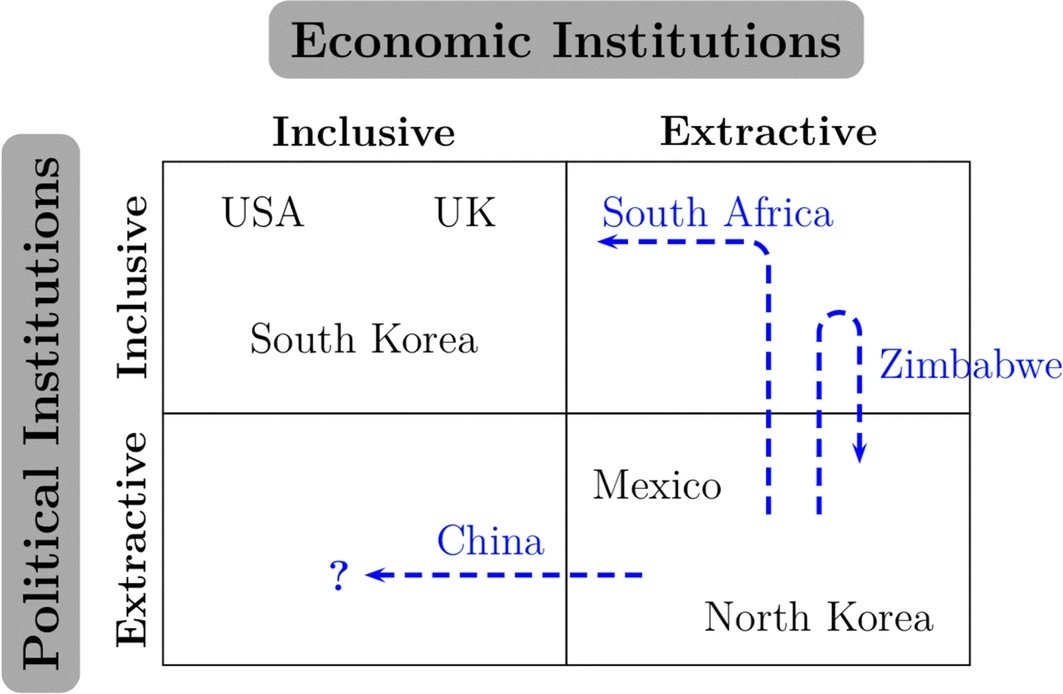Lecture 2.1
Institutions and Development
Institutions
What is an Institution?
“Humanly devised constraints that structure political, economic and social interaction. They consist of both informal constraints (sanctions, taboos, customs, traditions and codes of conduct), and formal rules (constitutions, laws, property rights).”
- Douglas North
Inclusive Institutions
- Inclusive institutions…“allow and encourage participation by the great mass of people in economic activities that make the best use of their talents and skills and enable individuals to make the choices they wish.”
- Economic: private property, unbiased legal system, banks, legally binding contracts, etc.
- Political: can take a variety of forms but must be pluralistic (constrained) with centralized and powerful state
Extractive Institutions
- Extractive institutions are…“designed to extract incomes and wealth from one subset of society to benefit a different subset.”
- Economic: limited or non-existent property rights, biased legal system, slavery
- Political: absolutist, repressive, may or may not be centralized
Key Arguments
Hypothesis 1: Inclusive economic institutions promote investment and economic growth, while extractive institutions discourage investment and hamper economic growth
Hypothesis 2: Inclusive political institutions encourage the development of inclusive economic institutions and vice-versa
Additional Considerations
Distribution of Authority

Acemoglu & Robinson, figure 3
Persistence and Change
- Why do extractive institutions persist?
- Industrial progress threatens the interests of dictators and other elites
- Polany’s “double movement”
- Schumpeter’s theory of “creative destruction”
- When do institutions change?
- Critical junctures (and small differences)
- e.g. disease \(\rightarrow\) shift in labor market dynamics
- Revolution gives a group new power
Reversal of Fortunes
- Extractive institutions make a region wealthy in one period, but poor in the next
- Examples?
Comparisons and Cases
North Korea vs. South Korea

North Korea nighttime lights
The United States vs. Mexico

Nogales Sonora (left), Nogales Arizona (right) in 2021
Other Cases

Acemoglu & Robinson, figure 4
Zimbabwe, South Africa & China

Source: Maddison Project Database, version 2018.
Growth Under Dictators
Some Famous Dictators



Growth Under Famous Dictators

Source: Maddison Project Database, version 2018.
Growth Under Repressive Regimes
- Growth under extractive institutions is possible
- When elite funnel resources to high productivity areas (e.g. USSR)
- When authoritarian regimes permit inclusive economic institutions (e.g. S. Korea under Park, China)
- But this growth is inherently limited
- Lack of incentives for innovation and production
- Resistance to creative destruction
- Infighting among the elite
Remaining Challenges
The United States

National Memorial for Peace and Justice
The United Kingdom

Girls rolling roads in India, 1930
Economic Impact of Colonialism

Source: Maddison Project Database, version 2018.
Endogeneity
- A relationship is “endogenous” when the direction of causality is unclear
- A&R hypothesize that inclusive institutions drive development
- But could inclusive institutions be the result of development?
- Or could there be a third factor driving both?
- What are some possibilities?
Exercise
- Write two or three sentences on what you found convincing about A&R’s theory
- Write two or three sentences on what you found problematic
- Discuss with a neighbor
